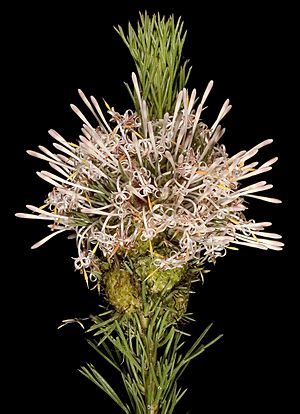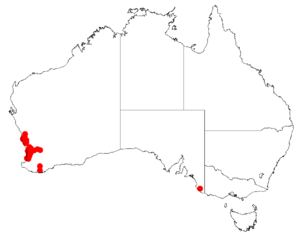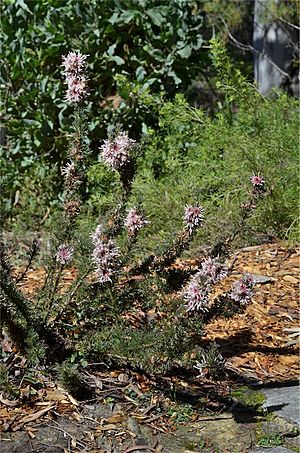Isopogon asper facts for kids
Quick facts for kids Isopogon asper |
|
|---|---|
 |
|
| Scientific classification | |
| Genus: |
Isopogon
|
| Species: |
asper
|
 |
|
| Occurrence data from Australasian Virtual Herbarium | |
| Synonyms | |
|
|
The Isopogon asper is a special kind of plant. It belongs to the Proteaceae family, which includes many unique Australian plants. This shrub is found only in the south-west part of Western Australia. This means it is endemic to that area, like a local celebrity plant!
It's a small shrub with lots of leaves packed together. Its flowers are pink, smooth, and shaped like flattened balls.
Contents
What Does Isopogon asper Look Like?
The Isopogon asper is a small shrub. It usually grows to be about 0.2 to 0.8 meters tall. That's less than a meter, so it's quite low to the ground! Its branches are reddish-brown and have tiny hairs.
Leaves and Flowers
The leaves of this plant are very crowded. They can be up to 20 millimeters long. That's about the length of two small buttons! The leaves are also pinnate, which means they have smaller parts arranged like a feather. These parts are either round or have grooves. They grow on a stalk called a petiole, which can be up to 13 millimeters long.
The flowers are very interesting. They grow in dense, flattened-round clusters. Each cluster can be up to 40 millimeters across. The flowers themselves are about 18 millimeters long. They are a lovely pink color and are glabrous, which means they are smooth and hairless.
When Does It Flower?
You can see the Isopogon asper flowering from June to October. After the flowers, the plant produces a fruit. This fruit is a hairy nut. Many of these nuts are joined together in a round head, which can be up to 20 millimeters wide.
How Was Isopogon asper Named?
The Isopogon asper was first officially described in 1830. A famous botanist named Robert Brown gave it its scientific name. He wrote about it in his book, Supplementum.
Robert Brown studied plants that were collected in 1827. These plants were found near the Swan River by another botanist, Charles Fraser.
Where Does Isopogon asper Live?
This special isopogon plant grows in areas with low, open heathland. Heathland is a type of natural land with small shrubs and plants. Often, the soil where it grows comes from granite rock.
You can find Isopogon asper in the south-west of Western Australia. Its range stretches from a town called Harvey all the way up to near Jurien Bay.
Is Isopogon asper Safe?
The Government of Western Australia's Department of Parks and Wildlife keeps an eye on plants like Isopogon asper. They have classified this plant as "not threatened." This means it's not currently in danger of disappearing, which is great news!


